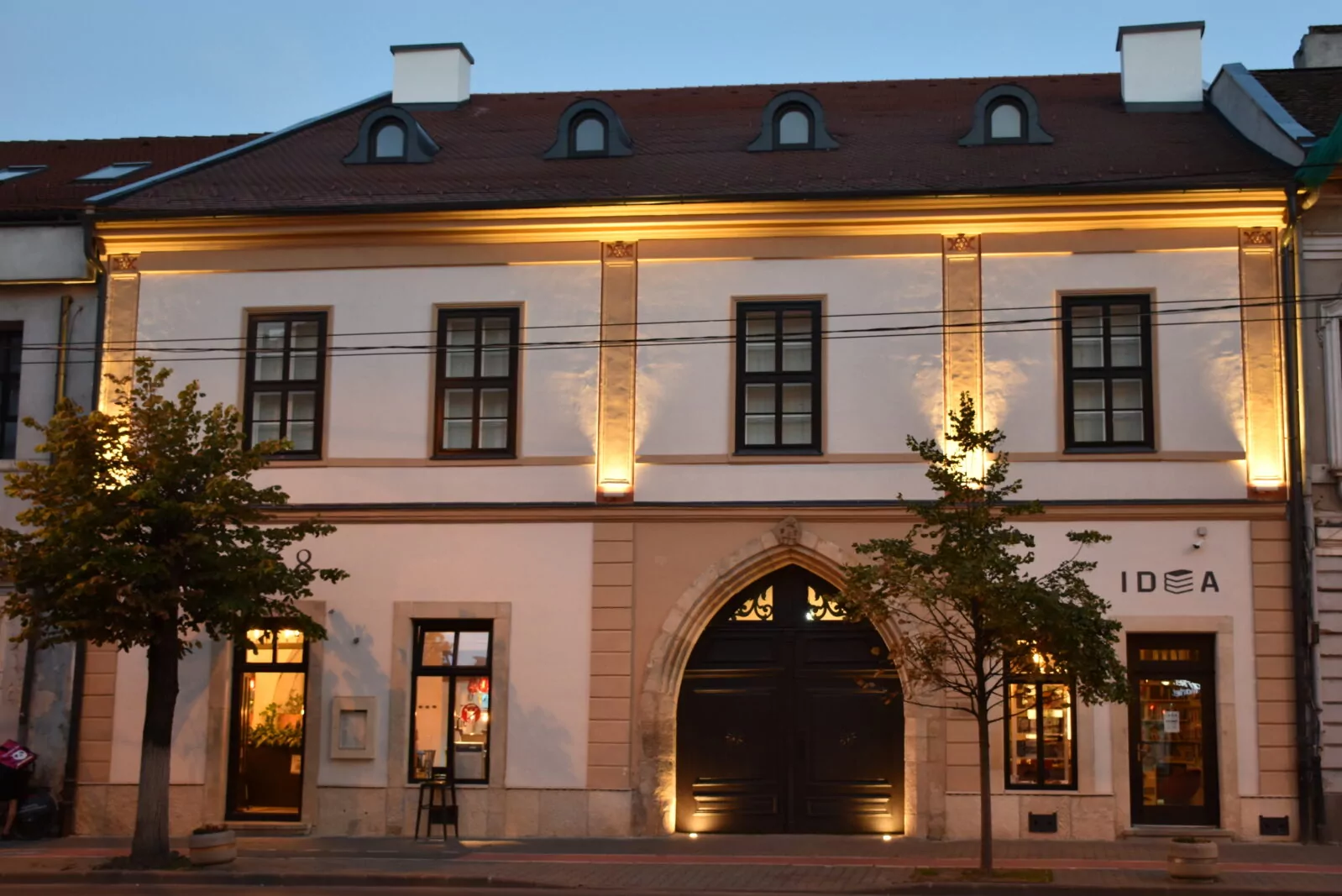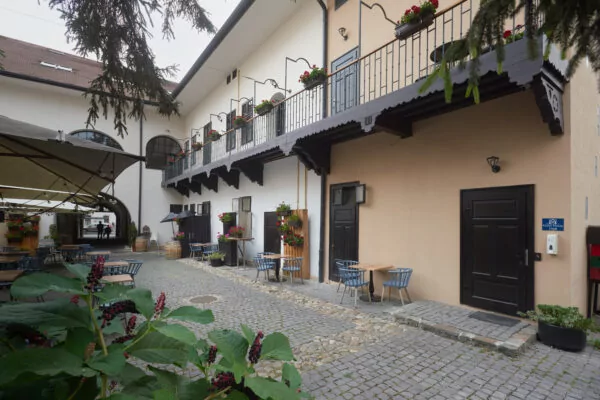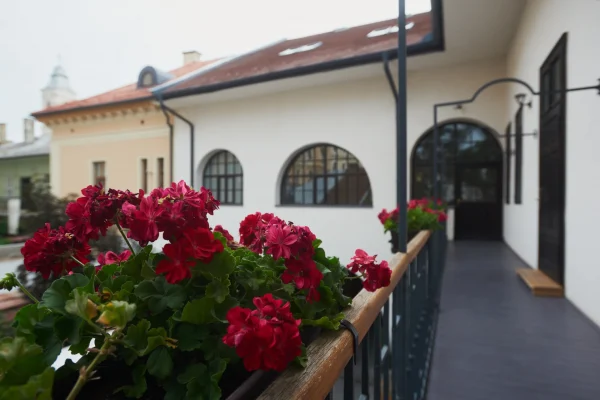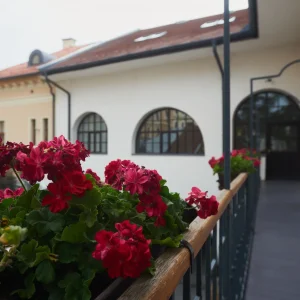About us:
The building of the former residence of the Unitarian bishops is one of the most important civilian House of Cluj preserving elements of Gothic architecture, which has been extended and modified several times during the centuries. The art historical and archaeological research that stands at the base of the planning has revealed numerous details on the history of the building, details that proved to be important also from the perspective of medieval and early modern culture history of Cluj and Transylvania.

I. The eastern side of the house featuring two rooms on every level is a stone building including basement, ground floor and first floor, built at the end of the 14th or the beginning of the 15th century. On the other side, West to the actual getaway, there was another smaller stone building. We do not know the name of the owners from this period.


II. We consider a second grade period of construction the second part of the 15th century, when the getaway was coped, thus the two houses were united, configurating an integrated first floor. The stairs leading to the first floor were added some stone handholds carved into the wall, a singular aspect so far regarding civilian houses in Transylvania. This is the period when the three big gothic straight arches of the getaway were made, just like the gothic gate itself, with its blazon. Beyond the the open arches of the getaway, on the right side, which at the time had gothic corbels and the wooden slab, probably there were some fireplaces, as the smoky floor walls might refer to. The man who built the house was one influential and well to do member of the local society, as he was buried in one of the couples of Saint Michael’s church, in the front of the altar. We can still see his blossom on the southern wall of the church. Unfortunately we do not know his name.
III. During the 16th and the 17th century the house has been modified several times. The facades were completed with renaissance style gravestone window frames a 17th century brick floor has survived, plus the rooms were heated with stoves according to the mode of those ages. However, most of the architectural innovations of this. Were lost and we have only secondary clues and fragmentary details of the presumably quite representatively elements.
IV. The next important changes came with the years 1736-1737 and later on, with the beginning of the 19th century, after 1811 , Bing all related to the Wesselényi family. At the first stage, during the massive constructing works initiated by Ferenc Wesselényi (1705-1771) , the medieval civilian house was transformed into the local residency of the family. Besides the great room and the one beyond it all the first floor rooms were copped, a barrack door frame was made in the getaway, and presumably this is the When the arched porch And it’s vaulted the staircase was made, the medieval and renaissance fireplaces were removed, and the interior decorations were standardized. After 1811 the building has become the local residency off Farkas Wesselényi Jr. (1782-1851) , a man known as a great music lover, who brought major changes to the inherited building in the following years. The Classicist façade And most of the empire style doors and windows were made in this. The stairwell was expanded and stilted. This is also the time when the empire parkedarquet-imitating painted floor of the saloon was made, on the first floor, which is a rare example of this kind of elaboration. The bakehouse and the kitchen, and next to the yard façade of the house, we’re still standing in this., and their research has brought to the light some unique Material in Cluj.
V. The actual configuration of the house is a result of the works in its initiated by Domokos Biasini (1821-1895) , when the first floor from the back side was erected on the spot of the former bakehouse, kitchen and stable, the former parts of the house were modernized, the arches were demolished, new slabs and the new rufing roofing was built. These modifications had to be made before 1869, as the land register from that your recoded already 15 rooms.
VI. In 1883 the Biasini family sold the building to the Unitarian church. The church has made only mirror recovery works, among other things it removed to the shingle, replacing it with a titled roof. Picture since then this house has been the residency of the Unitarian Bishop.
Owners: We do not know the name of the person who built the house in the 15th century. There was an expresion of the building in the second part of the 15th century, and the initiator of the representative gateway was an ifluential and well-to-do inhabitant of Cluj, whose blazon can be seen on the house and in the southern wall of St. Michael’s Church, but whose name is unknown.
Between 1590 and 1648 we know of several owners of the house , persumably guild masters. The certificates name the following: György Szabó (Georg Sabo) between1590-1609. Gábor Zsuponics (Supponicz) between 1609-1648, including his window after his death in 1639. In 1646 the building was acquired by tinsmith Merten Kannegieser. We donot know the owners form the second part of the 17th centruy , but the first decades of the next century the house became the property of the Koloszvári family . In 1732 theowner was Andás Kolozsvári a city senator. Around 1735 the building was acquired from this family by Ferenc Wesselényi , a member of the well-known aristocal family .At the middle of the 19th century Farkas Wesselényi and his family was using the first floor , therefore the ground floor was rented out. In 1845 we know of two tenants : a tailor named Mihály Csiszér and a leather worker: András Hadadi.
In 1853 the property was bought by merchant Domokos Biasini, the son of the famous Gaetano Biasini, the italian who had made a career in Cluj, running a fancing-school. A stagecoach service, and a hotel.
In 1883 the house was acqired by the Unitarian Church.
Guesthouse1568.ro

